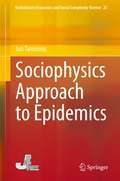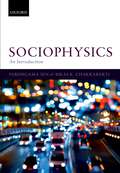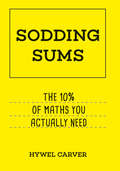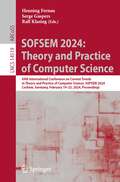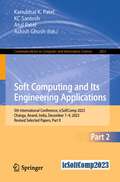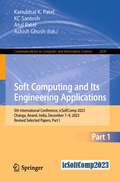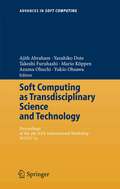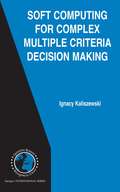- Table View
- List View
Sociophysics Approach to Epidemics (Evolutionary Economics and Social Complexity Science #23)
by Jun TanimotoThis book presents the fundamentals of evolutionary game theory and applies them to the analysis of epidemics, which is of paramount importance in the aftermath of the worldwide COVID-19 pandemic. The primary objective of this monograph is to deliver a powerful tool to model and analyze the spread of an infectious disease during a pandemic as well as the human decision dynamics. The book employs a variant of the “vaccination game,” in which a mathematical epidemiological model dovetails with evolutionary game theory. From a social physics standpoint, this book introduces an extended concept of the vaccination game starting from the fundamental issues and touching on the newest practical applications.The book first outlines the fundamental basis of evolutionary game theory, in which a two-player and two-strategy game, the so-called 2 × 2 game, and a multi-player game are concisely introduced, and the important issue of how social dilemmas are quantified is highlighted. Subsequently, the book discusses various recent applications of the extended concept of the vaccination game so as to quantitatively evaluate provisions other than vaccination, including practical intermediate protective measures such as mask-wearing, efficiency of quarantine compared with that of isolation policies for suppressing epidemics, efficiency of preemptive versus late vaccination, and optimal subsidy policies for vaccination.
Sociophysics: An Introduction
by Parongama Sen Bikas K. ChakrabartiThis book discusses the study and analysis of the physical aspects of social systems and models, inspired by the analogy with familiar models of physical systems and possible applications of statistical physics tools. Unlike the traditional analysis of the physics of macroscopic many-body or condensed matter systems, which is now an established and mature subject, the upsurge in the physical analysis and modelling of social systems, which are clearly many-body dynamical systems, is a recent phenomenon. Though the major developments in sociophysics have taken place only recently, the earliest attempts of proposing "Social Physics" as a discipline are more than one and a half centuries old. Various developments in the mainstream physics of condensed matter systems have inspired and induced the recent growth of sociophysical analysis and models. In spite of the tremendous efforts of many scientists in recent years, the subject is still in its infancy and major challenges are yet to be taken up. An introduction to these challenges is the main motivation for this book.
Sociopolitical Dimensions of Mathematics Education: From the Margin to Mainstream (ICME-13 Monographs)
by Murad Jurdak Renuka VithalThis book documents and expands on the diverse social and political dimensions of mathematics education issues, concerns, perspectives, contexts, and approaches presented in Topic Study Group 34 of the 13th International Congress on Mathematical Education (ICME-13). The book also argues for and promotes the mainstreaming of the sociopolitical dimensions of mathematics education through an ongoing critique and inquiry into content, policies, practices and theories. Accordingly, the main theme throughout the book is captured and illuminated by bringing voices from the margin to the mainstream. In this respect it is both aspirational and a reality, as evidenced by the increasing references to the sociopolitical dimensions in other areas of mathematics education—for example, in several of the plenary presentations at the ICME-13. The authors have reflected on their ideas with a view to orienting and enhancing research in the sociopolitical dimensions of mathematics education that is grounded in current education systems within their specific sociocultural contexts.
Sodding Sums: The 10% of maths you actually need
by Hywel CarverMaths is a part of everyday life and there's no denying it. For anyone who has blocked distant memories of complicated algebraic formulae or incomprehensible trigonometry, numbers can strike fear at your very core. It is, however, an unavoidable part of life, so why struggle through without a clue? Hywel Carver is passionate about making maths approachable for everyone. In his go-to guide he introduces handy arithme`tricks' that help solve multiplication and division problems with rounding and approximations; explains fractions, percentages and ratios, how to convert between them and understand increases, decreases and multiplication; delves into all types of conversions - metric versus imperial, Celsius to Fahrenheit, as well as distances and speeds. These mathematical theories can then be applied to common conundrums, such as how mortgages and loans actually work, grasping an understanding of compound interest, the chances and probability of success in gambling games, and how to analyse statistics and data including causality, coincidence and correlation. Sodding Sums will subtract stress and divide difficulty so you no longer feel clueless when challenged by maths.
SOFSEM 2019: 45th International Conference on Current Trends in Theory and Practice of Computer Science, Nový Smokovec, Slovakia, January 27-30, 2019, Proceedings (Lecture Notes in Computer Science #11376)
by Barbara Catania Rastislav Královič Jerzy Nawrocki Giovanni PighizziniThis book constitutes the refereed proceedings of the 45th International Conference on Current Trends in Theory and Practice of Computer Science, SOFSEM 2019, held in Nový Smokovec, Slovakia, in January 2019. The 34 full papers presented together with 6 invited talks were carefully reviewed and selected from 92 submissions. They presented new research results in the theory and practice of computer science in the each sub-area of SOFSEM 2019: Foundations of theoretical Computer Science, foundations of data science and engineering, and foundations of software engineering.
SOFSEM 2020: 46th International Conference on Current Trends in Theory and Practice of Informatics, SOFSEM 2020, Limassol, Cyprus, January 20–24, 2020, Proceedings (Lecture Notes in Computer Science #12011)
by Alexander Chatzigeorgiou Riccardo Dondi Herodotos Herodotou Christos Kapoutsis Yannis Manolopoulos George A. Papadopoulos Florian SikoraThis book constitutes the refereed proceedings of the 46th International Conference on Current Trends in Theory and Practice of Informatics, SOFSEM 2020, held in Limassol, Cyprus, in January 2020. The 40 full papers presented together with 17 short papers and 3 invited papers were carefully reviewed and selected from 125 submissions. They presented new research results in the theory and practice of computer science in the each sub-area of SOFSEM 2020: foundations of computer science, foundations of data science and engineering, foundations of software engineering, and foundations of algorithmic computational biology.
SOFSEM 2024: 49th International Conference on Current Trends in Theory and Practice of Computer Science, SOFSEM 2024, Cochem, Germany, February 19–23, 2024, Proceedings (Lecture Notes in Computer Science #14519)
by Henning Fernau Serge Gaspers Ralf KlasingThis book constitutes the proceedings of the 49th International Conference on Current Trends in Theory and Practice of Computer Science, SOFSEM 2024, held in Cochem, Germany, in February 2024. The 33 full papers presented in this book were carefully reviewed and selected from 81 submissions. The book also contains one invited talk in full paper length. They focus on original research and challenges in foundations of computer science including algorithms, AI-based methods, computational complexity, and formal models.
Soft and Hard Probes of QCD Topological Structures in Relativistic Heavy-Ion Collisions (Springer Theses)
by Shuzhe ShiThis thesis makes significant advances in the quantitative understanding of two intrinsically linked yet technically very different phenomena in quantum chromodynamics (QCD). Firstly, the thesis investigates the soft probe of strong interaction topological fluctuations in the quark-gluon plasma (QGP) which is made possible via the anomalous chiral transport effects induced by such fluctuations. Here, the author makes contributions towards establishing the first comprehensive tool for quantitative prediction of the chiral magnetic effect in the QGP that is produced in heavy ion collision experiments. Secondly, the thesis deals with the hard probe of strongly coupled QGP created in heavy-ion collisions. In particular, this study addresses the basic question related to the nonperturbative color structure in the QGP via jet energy loss observables. The author further develops the CUJET computational model for jet quenching and uses it to analyze the topological degrees of freedom in quark-gluon plasma. The contributions this thesis makes towards these highly-challenging problems have already generated widespread impacts in the field of quark-gluon plasma and high-energy nuclear collisions.
Soft Computing: Integrating Evolutionary, Neural, and Fuzzy Systems
by Andrea Tettamanzi Marco TomassiniSoft computing encompasses various computational methodologies, which, unlike conventional algorithms, are tolerant of imprecision, uncertainty, and partial truth. Soft computing technologies offer adaptability as a characteristic feature and thus permit the tracking of a problem through a changing environment. Besides some recent developments in areas like rough sets and probabilistic networks, fuzzy logic, evolutionary algorithms, and artificial neural networks are core ingredients of soft computing, which are all bio-inspired and can easily be combined synergetically.This book presents a well-balanced integration of fuzzy logic, evolutionary computing, and neural information processing. The three constituents are introduced to the reader systematically and brought together in differentiated combinations step by step. The text was developed from courses given by the authors and offers numerous illustrations as
Soft Computing and Its Engineering Applications: 5th International Conference, icSoftComp 2023, Changa, Anand, India, December 7–9, 2023, Revised Selected Papers, Part II (Communications in Computer and Information Science #2031)
by Kanubhai K. Patel Kc Santosh Atul Patel Ashish GhoshThe two-volume proceedings constitutes the refereed proceedings of the 5th International Conference on Soft Computing and its Engineering Applications, icSoftComp 2023, held in Changa, Anand, India, in December 2023. The 42 full papers and 2 short papers included in this book were carefully reviewed and selected from 351 submissions. They are organized in topical sections as follows: Volume number 2020: Theory and Methods; Systems and ApplicationsVolume number 2031: Systems and Applications; Hybrid Techniques.
Soft Computing and Its Engineering Applications: 5th International Conference, icSoftComp 2023, Changa, Anand, India, December 7–9, 2023, Revised Selected Papers, Part I (Communications in Computer and Information Science #2030)
by Kanubhai K. Patel Kc Santosh Atul Patel Ashish GhoshThe two-volume proceedings constitutes the refereed proceedings of the 5th International Conference on Soft Computing and its Engineering Applications, icSoftComp 2023, held in Changa, Anand, India, in December 2023. The 42 full papers and 2 short papers included in this book were carefully reviewed and selected from 351 submissions. They are organized in topical sections as follows: Volume number 2020: Theory and Methods; Systems and ApplicationsVolume number 2031: Systems and Applications; Hybrid Techniques.
Soft Computing and Optimization: SCOTA 2021, Ranchi, India, March 26–27 (Springer Proceedings in Mathematics & Statistics #404)
by Syeda Darakhshan Jabeen Javid Ali Oscar CastilloThis book collects papers presented at the Virtual International Conference on Soft Computing, Optimization Theory and Applications (SCOTA 2021), held at the Birla Institute of Technology, Mesra, Ranchi, India, from 26–27 March 2021. Topics discussed in the book are on fuzzy logic, neural networks and optimization algorithms, as well as their hybrid combinations, and their application in areas such as intelligent control and robotics, pattern recognition, medical diagnosis, time series prediction and optimization of complex problems. The book highlights research on: (a) hybrid intelligent systems based on soft computing, new concepts and algorithms based on fuzzy logic and their applications, (b) theory and practice of meta-heuristics in different areas of application, (c) applications of fuzzy logic, (d) neural networks and hybrid intelligent systems in medical applications, (e) neural networks and optimization and evolutionary algorithms and their different applications and (f) applications of fuzzy logic, neural networks and meta-heuristics in pattern recognition problems. Some papers contain applications background like approximate solution of fractional differential equations via fixed-point algorithms and applications to equilibrium problems and image deburring problems. The book will be of great use to students, researchers and scientists in computer science, optimization and engineering, and those interested on computational intelligence and soft computing and their applications.
Soft Computing Applications in Sensor Networks
by Sankar K. Pal Sudip MisraThis book uses tutorials and new material to describe the basic concepts of soft-computing which potentially can be used in real-life sensor network applications. It is organized in a manner that exemplifies the use of an assortment of soft-computing applications for solving different problems in sensor networking. Written by worldwide experts, the chapters provide a balanced mixture of different problems concerning channel access, routing, coverage, localization, lifetime maximization and target tracking using emerging soft-computing applications.
Soft Computing Applications in Sensor Networks
by Sudip Misra and Sankar K. PalThis book uses tutorials and new material to describe the basic concepts of soft-computing which potentially can be used in real-life sensor network applications. It is organized in a manner that exemplifies the use of an assortment of soft-computing applications for solving different problems in sensor networking. Written by worldwide experts, the chapters provide a balanced mixture of different problems concerning channel access, routing, coverage, localization, lifetime maximization and target tracking using emerging soft-computing applications.
Soft Computing Approach for Mathematical Modeling of Engineering Problems
by Ali AhmadianThis book describes different mathematical modeling and soft computing techniques used to solve practical engineering problems. It gives an overview of the current state of soft computing techniques and describes the advantages and disadvantages of soft computing compared to traditional hard computing techniques. Through examples and case studies the editors demonstrate and describe how problems with inherent uncertainty can be addressed and eventually solved through the aid of numerical models and methods. The chapters address several applications and examples in bioengineering science, drug delivery, solving inventory issues, Industry 4.0, augmented reality and weather forecasting. Other examples include solving fuzzy-shortest-path problems by introducing a new distance and ranking functions. Because, in practice, problems arise with uncertain data and most of them cannot be solved exactly and easily, the main objective is to develop models that deliver solutions with the aid of numerical methods. This is the reason behind investigating soft numerical computing in dynamic systems. Having this in mind, the authors and editors have considered error of approximation and have discussed several common types of errors and their propagations. Moreover, they have explained the numerical methods, along with convergence and consistence properties and characteristics, as the main objectives behind this book involve considering, discussing and proving related theorems within the setting of soft computing. This book examines dynamic models, and how time is fundamental to the structure of the model and data as well as the understanding of how a process unfolds • Discusses mathematical modeling with soft computing and the implementations of uncertain mathematical models • Examines how uncertain dynamic systems models include uncertain state, uncertain state space and uncertain state’s transition functions • Assists readers to become familiar with many soft numerical methods to simulate the solution function’s behaviorThis book is intended for system specialists who are interested in dynamic systems that operate at different time scales. The book can be used by engineering students, researchers and professionals in control and finite element fields as well as all engineering, applied mathematics, economics and computer science interested in dynamic and uncertain systems. Ali Ahmadian is a Senior Lecturer at the Institute of IR 4.0, The National University of Malaysia.Soheil Salahshour is an associate professor at Bahcesehir University.
Soft Computing Approach for Mathematical Modeling of Engineering Problems
by Ali Ahmadian Soheil SalahshourThis book describes different mathematical modeling and soft computing techniques used to solve practical engineering problems. It gives an overview of the current state of soft computing techniques and describes the advantages and disadvantages of soft computing compared to traditional hard computing techniques. Through examples and case studies the editors demonstrate and describe how problems with inherent uncertainty can be addressed and eventually solved through the aid of numerical models and methods. The chapters address several applications and examples in bioengineering science, drug delivery, solving inventory issues, Industry 4.0, augmented reality and weather forecasting. Other examples include solving fuzzy-shortest-path problems by introducing a new distance and ranking functions. Because, in practice, problems arise with uncertain data and most of them cannot be solved exactly and easily, the main objective is to develop models that deliver solutions with the aid of numerical methods. This is the reason behind investigating soft numerical computing in dynamic systems. Having this in mind, the authors and editors have considered error of approximation and have discussed several common types of errors and their propagations. Moreover, they have explained the numerical methods, along with convergence and consistence properties and characteristics, as the main objectives behind this book involve considering, discussing and proving related theorems within the setting of soft computing. This book examines dynamic models, and how time is fundamental to the structure of the model and data as well as the understanding of how a process unfolds • Discusses mathematical modeling with soft computing and the implementations of uncertain mathematical models • Examines how uncertain dynamic systems models include uncertain state, uncertain state space and uncertain state’s transition functions • Assists readers to become familiar with many soft numerical methods to simulate the solution function’s behaviorThis book is intended for system specialists who are interested in dynamic systems that operate at different time scales. The book can be used by engineering students, researchers and professionals in control and finite element fields as well as all engineering, applied mathematics, economics and computer science interested in dynamic and uncertain systems. Ali Ahmadian is a Senior Lecturer at the Institute of IR 4.0, The National University of Malaysia.Soheil Salahshour is an associate professor at Bahcesehir University.
Soft Computing as Transdisciplinary Science and Technology: Proceedings of the fourth IEEE International Workshop WSTST´05 (Advances in Intelligent and Soft Computing #29)
by Ajith Abraham Mario Köppen Yasuhiko Dote Takeshi Furuhashi Azuma Ohuchi Yukio OhsawaThis book presents the proceedings of the Fourth International Workshop on Soft Computing as Transdisciplinary Science and Technology (WSTST '05), May 25-27, 2005, Muroran, Japan. It brings together the original work of international soft computing/computational intelligence researchers, developers, practitioners, and users. This proceedings provide contributions to all areas of soft computing including intelligent hybrid systems, agent-based systems, intelligent data mining, decision support systems, cognitive and reactive distributed artificial intelligence (AI), internet modelling, human interface, and applications in science and technology.
Soft Computing Based Optimization and Decision Models: To Commemorate the 65th Birthday of Professor José Luis "Curro" Verdegay (Studies in Fuzziness and Soft Computing #360)
by David A. Pelta Carlos Cruz CoronaThis book offers a timely snapshot of current soft-computing research and solutions to decision-making and optimization problems, which are ubiquitous in the current social and technological context, addressing fields including logistics, transportation and data analysis. Written by leading international experts from the United States, Brazil and Cuba, as well as the United Kingdom, France, Finland and Spain, it discusses theoretical developments in and practical applications of soft computing in fields where these methods are crucial to obtaining better models, including: intelligent transportation systems, maritime logistics, portfolio selection, decision- making, fuzzy cognitive maps, and fault detection. The book is dedicated to Professor José L. Verdegay, a pioneer who has been actively pursuing research in fuzzy sets theory and soft computing since 1982, in honor of his 65th birthday.
Soft Computing for Complex Multiple Criteria Decision Making (International Series in Operations Research & Management Science #85)
by Ignacy KaliszewskiThis book concentrates on providing technical tools to make the user of Multiple Criteria Decision Making (MCDM) methodologies independent of bulky optimization computations. These bulky computations have been a necessary, but limiting, characteristic of interactive MCDM methodologies and algorithms. The book removes these limitations of MCDM problems by reducing a problem's computational complexity. The result is a wider and more functional general framework for presenting, teaching, implementing and applying a wide range of MCDM methodologies.
Soft Computing for Control of Non-Linear Dynamical Systems (Studies in Fuzziness and Soft Computing #63)
by Oscar Castillo Patricia MelinThis book presents a unified view of modelling, simulation, and control of non linear dynamical systems using soft computing techniques and fractal theory. Our particular point of view is that modelling, simulation, and control are problems that cannot be considered apart, because they are intrinsically related in real world applications. Control of non-linear dynamical systems cannot be achieved if we don't have the appropriate model for the system. On the other hand, we know that complex non-linear dynamical systems can exhibit a wide range of dynamic behaviors ( ranging from simple periodic orbits to chaotic strange attractors), so the problem of simulation and behavior identification is a very important one. Also, we want to automate each of these tasks because in this way it is more easy to solve a particular problem. A real world problem may require that we use modelling, simulation, and control, to achieve the desired level of performance needed for the particular application.
Soft Computing for Information Processing and Analysis (Studies in Fuzziness and Soft Computing #164)
by Masoud Nikravesh Lofti A. ZadehSearch engines, with Google at the top, have become the most heavily used online service, with millions of searches performed every day and many remarkable capabilities. Soft Computing for Information Processing and Analysis includes reports from the front of soft computing in the internet industry and imparts knowledge and understanding of the significance of the field's accomplishments, new developments and future directions. This carefully edited book has evolved from presentations made by the participants of a meeting entitled "Fuzzy Logic and the Internet: Enhancing the Power of the Internet", organized by the Berkeley Initiative in Soft Computing (BISC), University of California, Berkeley. It addresses the important topics of modern search engines such as fuzzy query, decision analysis and support systems, including articles about topics such as Web Intelligence, World Knowledge and Fuzzy Logic (by Lotfi A. Zadeh), perception based information processing, or web intelligence.
Soft Computing for Knowledge Discovery: Introducing Cartesian Granule Features (The Springer International Series in Engineering and Computer Science #570)
by James G. ShanahanKnowledge discovery is an area of computer science that attempts to uncover interesting and useful patterns in data that permit a computer to perform a task autonomously or assist a human in performing a task more efficiently. Soft Computing for Knowledge Discovery provides a self-contained and systematic exposition of the key theory and algorithms that form the core of knowledge discovery from a soft computing perspective. It focuses on knowledge representation, machine learning, and the key methodologies that make up the fabric of soft computing - fuzzy set theory, fuzzy logic, evolutionary computing, and various theories of probability (e.g. naïve Bayes and Bayesian networks, Dempster-Shafer theory, mass assignment theory, and others). In addition to describing many state-of-the-art soft computing approaches to knowledge discovery, the author introduces Cartesian granule features and their corresponding learning algorithms as an intuitive approach to knowledge discovery. This new approach embraces the synergistic spirit of soft computing and exploits uncertainty in order to achieve tractability, transparency and generalization. Parallels are drawn between this approach and other well known approaches (such as naive Bayes and decision trees) leading to equivalences under certain conditions. The approaches presented are further illustrated in a battery of both artificial and real-world problems. Knowledge discovery in real-world problems, such as object recognition in outdoor scenes, medical diagnosis and control, is described in detail. These case studies provide further examples of how to apply the presented concepts and algorithms to practical problems. The author provides web page access to an online bibliography, datasets, source codes for several algorithms described in the book, and other information. Soft Computing for Knowledge Discovery is for advanced undergraduates, professionals and researchers in computer science, engineering and business information systems who work or have an interest in the dynamic fields of knowledge discovery and soft computing.
Soft Computing for Risk Evaluation and Management: Applications in Technology, Environment and Finance (Studies in Fuzziness and Soft Computing #76)
by Da Ruan Mario FedrizziRisk is a crucial element in virtually all problems people in diverse areas face in their activities. It is impossible to find adequate models and solutions without taking it into account. Due to uncertainty and complexity in those problems, traditional "hard" tools and techniques may be insufficient for their formulation and solution. This is the first book in the literature that shows how soft computing methods (fuzzy logic, neural networks, genetic algorithms, etc.) can be employed to deal with various problems related to risk analysis, evaluation and management in various fields of technology, environment and finance.
Soft Computing for Sustainability Science (Studies in Fuzziness and Soft Computing #358)
by Carlos Cruz CoronaThis book offers a timely snapshot of soft computing methodologies and their applications to various problems related to sustainability, including electric energy consumption; fault diagnosis; vessel fuel consumption; determining the best sites for new malls; maritime port projects; and ad-hoc vehicular networks. Further, it demonstrates how metaheuristics and machine learning methods, fuzzy linear programming, neural networks, computing with words, linguistic models and other soft computing methods can be efficiently used to solve real-world problems. Intended as a practice-oriented guide for students, researchers, and professionals working at the interface between computer science, industrial engineering, naval engineering, agriculture, and sustainable development / climate change research, it provides readers with a set of intelligent solutions, helping them answer a range of emerging questions related to sustainability.
Soft Computing in Acoustics: Applications of Neural Networks, Fuzzy Logic and Rough Sets to Musical Acoustics (Studies in Fuzziness and Soft Computing #31)
by Bozena KostekApplications of some selected soft computing methods to acoustics and sound engineering are presented in this book. The aim of this research study is the implementation of soft computing methods to musical signal analysis and to the recognition of musical sounds and phrases. Accordingly, some methods based on such learning algorithms as neural networks, rough sets and fuzzy-logic were conceived, implemented and tested. Additionally, the above-mentioned methods were applied to the analysis and verification of subjective testing results. The last problem discussed within the framework of this book was the problem of fuzzy control of the classical pipe organ instrument. The obtained results show that computational intelligence and soft computing may be used for solving some vital problems in both musical and architectural acoustics.
